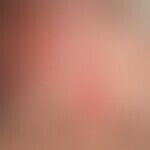Synonym(s)
DefinitionThis section has been translated automatically.
ClassificationThis section has been translated automatically.
Classification of primary scarring alopecia (PVA) according to histopathological criteria as recommended by the North American Hair Research Society (Olsen EA et al. 2003).
PVA group I (lymphocytic)
- Lupus erythematosus chronicus discoides of the scalp
- Lichen planus follicularis capillitii(also known as Lasseur-Graham-Little syndrome)
- Lichen planopilaris (not to be confused with lichen planus follicularis!)
- Pseudopélade Brocq
- Central centrifugal cicatricial alopecia
- Keratosis follicularis spinulosa decalvans
- Frontal fibrosing alopecia (Kossard)
PVA group II (neutrophilic)
PVA group III (mixed cell)
PVA group (non-specific)
- Idiopathic scarring alopecia with non-specific clinical and histopathological findings.
- End stage of various inflammatory scarring alopecias.
Classification of secondary scarring alopecias according to etiologic criteria (varied according to Kanti V et al. 2018).
Physical or chemical trauma
- Burn
- Caustic or acid burns
- Ischemia/pressure
- Traction alopecia
- Trichotillomania (advanced stage)
Ionizing radiations
- Therapeutic irradiations
Infections
- Bacterial infections
- Viral infections (e.g. necrotizing zoster)
- Mycoses(Tinea capitis profunda)
Tumors
- Primary tumors
- Metastases
- Lymphoproliferative diseases
- Epidermal and organoid nevi (e.g. nevus sebaceus)
Genodermatoses
- Aplasia cutis congenita
- Ectodermal dysplasias
- Ichthyosis
- Epidermolysis bullosa
- Darier's disease
- Incontinentia pigmenti
- Hyalinosis cutis et mucosae
Granulomatous diseases
- Sarcoidosis
- Necrobiosis lipoidica
Autoimmune diseases
- Graft-versus-host disease
- Scleroderma en coup de sabre
- Blistering diseases (pemphigus vulgaris, pemphigoid scarring type Brunsting-Perry)
Depositional dermatoses
- Amyloidosis
- Mucinosis
Inflammatory diseases
Drugs (rare)
- Busulfan
You might also be interested in
EtiopathogenesisThis section has been translated automatically.
- see classification below
DiagnosisThis section has been translated automatically.
Medical history:
- Family anamnesis
- Cosmetic analysis and hair care (chemical or physical smoothing or waving procedures, traction, professional or personal headgear (e.g. helmets)
- environment analysis: pets, professional animal contact
- Previously known significant and permanent diseases
- Initial manifestation (age)
- First-time or chronic or chronically recurrent course
- Effluvium (currently active hair loss)
- Effluvium diffuse or localised
- Malperceptions (burning, pain, pruritus) with time documentation (never, rarely, intermittently, continuously)
- Gynaecological history (ovulation inhibitor, menopause)
- medication (continuous, intermittent regular, irregular)
Clinical examination:
- Inspection of the scalp (extension and pattern of alopecia, signs of inflammation, follicular erythema, pustules, erosions, increased scaling), tufts of hair, hair shaft sheaths (follicular casts).
- Dermatoscopy (follicles in the centre of the lesion preserved or absent, follicular hyperkeratoses). It is important to distinguish it from alopecia areata (follicular structure preserved)
- Plucking test (hair can be extracted painlessly)
- Inspection of the entire integument (indications for lichen planus, psoriasis, lupus erythematosus, blistering autoimmune disease), the mucous membranes (especially oral mucosa), the nails (especially fingernails).
- Laboratory diagnostics:
- Standard profile; special laboratory depending on clinical symptoms, if necessary microbiological diagnostics.
- Biopsy: Sufficiently deep, follicular apparatus (follicleostium strictly in the middle of a 4 mm diameter punch biopsy). Punch biopsy from the still follicle-bearing marginal area of the lesion (the scarred area is not histologically significant).
- With questionable. Autoimmune diseases, an immunofluorescence examination is diagnostically valuable.
Differential diagnosisThis section has been translated automatically.
External therapyThis section has been translated automatically.
- The treatment naturally depends on the underlying disease.
- In the acute phase of an underlying inflammatory disease ( lichen planus, lupus erythematosus) the external application of glucocorticoids as a tincture or cream can be attempted in addition to specific systemic treatment, e.g. 2 times/day prednicarbate Lsg. (e.g. Dermatop), Mometasone Lsg. (e.g. Ecural), triamcinolone (e.g. Volon A tincture), betamethasone (e.g. Betnesol-V-crinale, Celestan-V-crinale).
- Alternatively, intralesional, intracutaneous injections of triamcinolone crystal suspension (e.g. Volon A 10 diluted 1:2 to 1:5 e.g. with mepivacaine). This is primarily intended to stop the further scarring process. Permanent alopecia at the scarred areas.
Notice! When glucocorticoid crystal suspensions are injected in the temporal and anterior parietal region, there is a risk of crystals being carried over into the retinal arteries with subsequent blindness!
Operative therapieThis section has been translated automatically.
LiteratureThis section has been translated automatically.
- Kanti V et al (2018) Scarring alopecia. JDDG 16: 435-461
- Olsen EA et al (2003) Summary of North American Hair Research Society (NAHRS)-sponsered Workshop on Cicatricial Alopecia, Duke University Medical Center, February 10 and 11, 2001 J Am Acad Dermatol 48: 103
Incoming links (12)
Alopecia cicatricans; Alopecia marginalis; Erythrokeratodermia progressive, type burns; Keratosis follicularis spinulosa decalvans; Lipoid proteinosis; Lupus erythematodes chronicus discoides; Neonatal-ithyosis-sclerosing-cholangitis-syndrome; Pemphigoid scarring type brunsting-perry; Pseudopécharge state; Psoriasis capitis; ... Show allOutgoing links (32)
Acne keloidalis nuchae; Acne necrotica; Alopecia (overview); Aplasia cutis congenita (overview); Central centrifugal scarring alopecia; Dyskeratosis follicularis; Erosive pustular dermatosis of the scalp; Excision; Folliculitis decalvans; Folliculitis et perifolliculitis capitis abscedens et suffodiens; ... Show allDisclaimer
Please ask your physician for a reliable diagnosis. This website is only meant as a reference.













